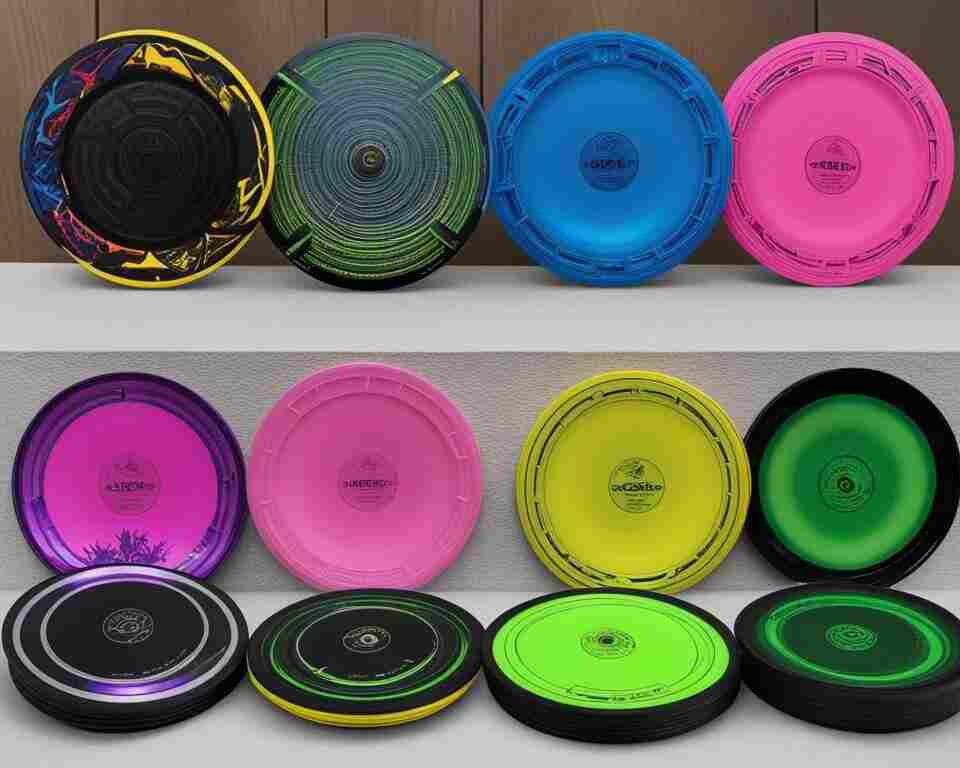Welcome to the exciting world of disc golf! Whether you’re a beginner looking to learn the ropes or someone who wants to improve their game, this comprehensive guide will provide you with all the information you need to get started. Disc golf is a fantastic recreational activity that combines physical exercise, mental stimulation, and a whole lot of fun. So, let’s dive in and explore the basics of how to play disc golf for beginners!
Key Takeaways:
- Disc golf is a healthy and recreational activity that offers physical and mental benefits.
- It is played like traditional golf, but instead of using clubs and balls, players use flying discs.
- The objective is to complete each hole in the fewest throws possible.
- Disc golf can be enjoyed by people of all ages and fitness levels, making it a great lifetime fitness activity.
- Equip yourself with the right discs and learn the rules, techniques, and strategies for success in disc golf.
What is Disc Golf?
Disc golf is a sport that combines the principles of traditional golf with the fun and excitement of throwing a flying disc. Similar to golf, players aim to complete each hole in the fewest throws possible. Instead of using clubs and balls, disc golfers use a variety of discs, each designed for specific throws and distances.
Disc golf is played on courses that feature a series of holes, typically 18 in total. Each hole has a designated tee area from which players throw their discs towards a target, usually an elevated metal basket. The objective is to get the disc into the target using the fewest throws possible, just like sinking a ball into a golf hole.
Disc golf shares many similarities with traditional golf, such as the concept of pars for each hole. Instead of yards, disc golf uses a par system based on the distance and difficulty of each hole. Just like golfers, disc golfers strive to improve their skills and lower their scores with each round they play.
Disc golf is a sport that can be enjoyed by people of all ages and fitness levels. It provides a great way to spend time outdoors, engage in physical activity, and connect with friends and family. Whether you’re a seasoned golfer looking for a new challenge or a beginner looking for a fun and accessible sport, disc golf offers a unique and exciting experience.
| Disc Golf Definition | Disc Golf Object | Disc Golf Holes |
|---|---|---|
| Disc golf is a sport that combines the principles of traditional golf with the fun and excitement of throwing a flying disc. | The object of disc golf is to complete each hole in the fewest throws possible, using a variety of discs designed for different distances and throws. | Disc golf holes are designated areas on the course with a tee area and a target, typically an elevated metal basket, where players aim to throw their discs into. |
Getting Started: What You Will Need
Before you dive into the exciting world of disc golf, it’s important to have the right equipment. Here are the essentials you’ll need to get started:
- Disc Golf Discs: The most important piece of equipment in disc golf is, of course, the discs themselves. There are different types of discs designed for different throws, such as putters, mid-ranges, and drivers. As a beginner, it’s recommended to start with a lightweight, mid-range disc. You can purchase disc golf discs from sporting goods stores or online retailers.
- Disc Golf Starter Pack: If you’re new to disc golf and unsure about which discs to choose, consider getting a disc golf starter pack. These packs typically include a selection of discs that are suitable for beginners, giving you a variety of options to try out and experiment with.
- Disc Golf Courses: To play disc golf, you’ll need access to a disc golf course. Fortunately, there are thousands of disc golf courses available worldwide, making it easy to find one near you. Many public parks have disc golf courses, and there are also dedicated disc golf facilities. Do some research to find the best course for your skill level and location.
- Disc Golf Retailers: When shopping for disc golf equipment, it’s helpful to know where to find reputable retailers. Look for sporting goods stores that specialize in disc golf, or explore online retailers that offer a wide selection of discs and accessories. This way, you can compare prices and read reviews to make informed purchasing decisions.
With these essentials in hand, you’ll be ready to hit the disc golf course and start enjoying this exciting sport!
Table: Disc Golf Disc Types
| Disc Type | Description |
|---|---|
| Putter | Designed for accurate short-range shots, including putting into the basket. |
| Mid-Range | Intended for controlled throws over moderate distances, offering balance between accuracy and distance. |
| Driver | Designed for maximum distance, allowing players to achieve long throws. |
Table: Disc Golf Disc Types
The Rules of Disc Golf
When playing disc golf, it is important to understand and follow the rules set by the Professional Disc Golf Association (PDGA). These rules ensure fair play and maintain the integrity of the game. Here are some of the key rules to keep in mind:
- Throwing from designated tees: Each hole has a designated tee area from which players must throw their disc. It is important to start each hole from the appropriate tee.
- Throwing in a specific order: Players take turns throwing their discs, with the player farthest from the target throwing first. This order is maintained throughout the hole.
- Counting the number of throws: The objective is to complete each hole in the fewest throws possible. Each time a player throws their disc, it counts as one throw. The total number of throws is recorded for each hole and added up at the end of the round.
In addition to these basic rules, it is important to follow proper disc golf etiquette. This includes remaining quiet when others are throwing, allowing players to concentrate and focus on their shots. It also means respecting the course and nature by not littering and using designated trash bins. By following both the rules and etiquette of disc golf, you can ensure an enjoyable and fair experience for yourself and others.
Remember, disc golf is a game that emphasizes sportsmanship and respect for others. By adhering to the rules and practicing good etiquette, you can contribute to a positive and inclusive disc golf community.
For a more detailed explanation of the rules and etiquette, you can refer to the PDGA official rulebook available on their website. Familiarize yourself with the rules before playing in organized tournaments or leagues to ensure a smooth and enjoyable experience. Keep in mind that local courses may also have specific rules and guidelines, so it’s always a good idea to check with the course staff or regular players for any additional information.
| PDGA Rule | Description |
|---|---|
| 804.01 | Throwing from a marked lie |
| 803.01 | Order of play |
| 806.01 | Counting throws |
| 801.01 | General courtesy |
| 801.02 | Littering |
By familiarizing yourself with the rules and etiquette of disc golf, you can enjoy the game to its fullest and be a respectful member of the disc golf community.

Throwing Techniques in Disc Golf
Mastering different throwing techniques in disc golf is essential to improve your game and achieve greater accuracy and distance. There are two main throwing techniques: the backhand throw and the forehand throw. Each technique has its advantages and is used in different situations on the course.
The backhand throw is the most common technique in disc golf and is similar to throwing a Frisbee. To execute a backhand throw, grip the disc with your fingers on the inside rim and your thumb on top. Face the target with your shoulder pointing towards it, and as you release the disc, use a sweeping motion across your body. This technique provides good distance and control, allowing the disc to fly straight or curve in the desired direction.
The forehand throw, also known as the sidearm throw, involves gripping the disc with your fingers on the rim and your thumb on the flight plate. Unlike the backhand throw, the forehand throw requires the throwing shoulder to be further from the target. Push the disc out towards the target with a flicking motion, using your wrist and forearm. The forehand throw is useful for navigating tight spaces and executing precise shots around obstacles.
Disc Golf Putting
Putting is a crucial aspect of disc golf, as it determines whether you can successfully complete a hole. The goal of putting is to release the disc with accuracy and enough power to reach the basket without overshooting or falling short. Here are some key tips to improve your putting technique:
- Find a comfortable putting stance and grip that works for you.
- Focus on maintaining balance and a fluid motion as you release the disc.
- Develop a consistent pre-putt routine to help you stay focused and confident.
- Practice regularly to build muscle memory and improve your aim.
Remember, putting can be a mental game as well, so stay confident and focused on your target. With practice and dedication, you can become a skilled putter and improve your overall disc golf game.
Disc Selection and Flight Characteristics
When it comes to disc golf, choosing the right disc is essential for achieving the desired flight characteristics. Discs come in various categories and have distinct stability, rotation, and release angle. Understanding these factors can significantly impact your throws and overall performance on the course.
The Categories of Disc Golf Discs
Discs can be categorized into four main types: putters, mid-ranges, fairway drivers, and distance drivers. Putters have a slower speed and are primarily used for shorter throws, accuracy, and putting. Mid-ranges provide a balance between control and distance, making them suitable for a variety of shots. Fairway drivers offer controlled distance and are often used for navigating more technical fairways. Distance drivers have a higher speed and are designed to maximize distance but can be more challenging to control for beginners.
Disc Stability and Rotation
Disc stability refers to the disc’s tendency to turn or fade during flight. Stability is influenced by the disc’s design, weight distribution, and the player’s throwing technique. Overstable discs are more resistant to turning and tend to fade left (for right-handed backhand throws). Understable discs, on the other hand, turn more and may fade right. It’s important to experiment with different stability ratings to find discs that suit your throwing style.
Release Angle and Flight Path
The release angle of the disc at the moment of the throw also affects its flight path. The two main release angles in disc golf are hyzer and anhyzer. A hyzer release is when the leading edge of the disc is tilted down, causing it to fly in a stable or left-turning path. An anhyzer release is the opposite, with the leading edge tilted up, resulting in a right-turning flight. Mastering different release angles can provide versatility in navigating obstacles and reaching your target.
Table: Disc Golf Disc Flight Characteristics
| Disc Type | Stability | Rotation | Release Angle |
|---|---|---|---|
| Putter | Varies (Overstable to Understable) | Varies (Clockwise or Counter-Clockwise) | Neutral to Hyzer |
| Mid-Range | Varies (Overstable to Understable) | Varies (Clockwise or Counter-Clockwise) | Neutral to Hyzer/Anhyzer |
| Driver | Varies (Overstable to Understable) | Varies (Clockwise or Counter-Clockwise) | Neutral to Hyzer/Anhyzer |
Keep in mind that these flight characteristics are not absolute and can vary based on individual disc molds and player technique. It’s recommended to experiment with different discs and practice different throwing techniques to gain a better understanding of how they perform in various situations.

Strategies for Success in Disc Golf
When it comes to playing disc golf, having effective strategies can make a significant difference in your performance on the course. By understanding and implementing these strategies, you can improve your shot selection, navigate obstacles, and maximize your chances of success.
Shot Shapes: Hyzer and Anhyzer
One key strategy in disc golf is utilizing different shot shapes to navigate the fairway and reach the basket. The two primary shot shapes used by players are hyzer and anhyzer throws. A hyzer throw involves releasing the disc with an angle that is tilted towards the ground, causing it to curve to the left (for right-handed players) or to the right (for left-handed players). An anhyzer throw, on the other hand, involves releasing the disc with an angle that is tilted away from the ground, causing it to curve to the right (for right-handed players) or to the left (for left-handed players). By mastering these shot shapes, you can effectively maneuver around obstacles and adjust your trajectory to match the fairway layout.
Shot Selection: Choosing the Right Disc
Another crucial aspect of disc golf strategy is selecting the right disc for each throw. Discs come in different types, such as drivers, mid-ranges, and putters, each designed for specific flight characteristics. Understanding the flight ratings of discs, including speed, glide, turn, and fade, can help you choose the most suitable disc for the distance, wind conditions, and shot shape required. It’s also important to consider your own throwing style and skill level when selecting a disc. Experimenting with different discs during practice rounds can help you identify which ones work best for your game.
Course Management: Understanding the Layout
A successful disc golf strategy also involves effective course management. Before playing a new course, take the time to study the layout and understand the various challenges it presents. Familiarize yourself with the distance and difficulty of each hole, as well as any unique features such as elevation changes, water hazards, or heavily wooded areas. By strategically planning your shots based on the course layout and your own capabilities, you can make informed decisions that optimize your chances of success. Additionally, mental preparation and staying focused throughout the round can contribute to better course management and overall performance.
Disc Golf Course Selection
When it comes to disc golf, choosing the right course can greatly impact your playing experience. Whether you’re a beginner or an experienced player, considering factors such as course difficulty, features, and ratings can help you make an informed decision.
Course difficulty varies from course to course, with some designed for beginners and others offering more challenging layouts. If you’re just starting out, it’s advisable to choose a course that is beginner-friendly, with shorter and less technical holes. This will allow you to practice your throws and develop your skills without feeling overwhelmed. On the other hand, if you’re an experienced player looking for a challenge, opt for a course with longer holes and various obstacles to test your skills.
Numerous online tools are at your disposal to help you locate suitable disc golf courses in your local area. You have the option to explore various websites, such as Professional Disc Golf Association and the Disc Golf Course Review, or take advantage of the UDisc app, which offers both a free basic account setup and premium plans that include interactive scorecards, personalized statistics, and a host of other impressive features. Additionally, player-generated course reviews can provide valuable insights into the courses’ levels of difficulty.
“Choosing the right disc golf course is crucial for having a great time on the course. I always look for a course with a good variety of hole lengths and shot requirements.” – Disc Golf Enthusiast
Course features can also add to the enjoyment of the game. Some courses offer elevation changes, such as uphill and downhill shots, which can add a unique element to your throws. Water hazards, such as ponds or creeks, can also make the game more exciting but may require additional skill and caution. Additionally, wooded areas can provide a scenic backdrop and present strategic shot selection opportunities.
| Course Difficulty | Course Features | Course Ratings |
|---|---|---|
| Beginner-friendly courses with shorter and less technical holes | Elevation changes, water hazards, wooded areas | Quality and difficulty rating |
| Challenging layouts with longer holes and obstacles |
When considering different courses, it can be helpful to research and read reviews about their ratings. Course ratings can provide insight into the quality and difficulty of the course, giving you a better idea of what to expect. Keep in mind that ratings may vary depending on the source, so it’s a good idea to read multiple reviews to get a well-rounded understanding of the course.
By taking into account course difficulty, features, and ratings, you can find a disc golf course that suits your skill level and preferences. Whether you’re looking for a beginner-friendly course or a challenging layout, there are plenty of options available. So grab your discs, explore different courses, and enjoy the thrill of disc golf!

Disc Golf Tips for Beginners
As a beginner in disc golf, there are several tips that can help you improve your game. Practice regularly to build consistency and improve your technique. Focus on mastering the basics, such as proper grip, body positioning, and follow-through. Seek advice from more experienced players and watch online tutorials for guidance. Remember to have fun and enjoy the process of learning and improving in disc golf.
One important aspect of disc golf is consistency in practice. By dedicating regular practice sessions, you can improve your throwing technique and develop muscle memory. Start with shorter throws and gradually increase the distance as you become more comfortable. As you practice, pay attention to your grip on the disc and experiment with different grips to find what works best for you.
It’s also crucial to focus on mastering the basics of disc golf. Proper body positioning is essential for accurate throws. Make sure your feet are shoulder-width apart, with your dominant foot slightly in front. This will provide you with a stable base to generate power and control during your throw. Additionally, focus on your follow-through, ensuring a smooth and fluid motion after releasing the disc.
Seeking advice from experienced players can significantly enhance your learning curve. Join local disc golf clubs, attend tournaments, and engage in conversations with seasoned players. They can provide valuable insights, techniques, and strategies that can improve your game. Additionally, watching online tutorials and instructional videos can further supplement your knowledge and help you refine your techniques.
Tips for Beginners:
- Practice regularly to build consistency and improve technique.
- Focus on mastering the basics of grip, body positioning, and follow-through.
- Seek advice from experienced players and watch online tutorials.
- Have fun and enjoy the process of learning and improving.
Disc Golf Safety and Etiquette
When playing disc golf, it is important to prioritize safety to ensure an enjoyable experience for everyone on the course. Here are some key safety guidelines to follow:
- Be aware of your surroundings: Before throwing, make sure the fairway is clear of other players and any potential hazards. Always be mindful of nearby pedestrians or wildlife.
- Use caution when throwing: Discs can reach high speeds and may cause injury if they hit someone. Take care to throw with control and be mindful of your aim.
- Respect other players: Wait for your turn to throw and maintain a safe distance from other players on the course. Avoid distracting or interfering with their throws.
- Keep the course clean: Disc golf courses are often located in beautiful natural settings. Be sure to pick up after yourself and dispose of any trash properly. Leave the course in the same condition you found it.
Etiquette is also important in disc golf to create a positive atmosphere for everyone involved. Here are some etiquette guidelines to follow:
- Remain quiet during throws: Avoid talking or making loud noises when another player is about to throw. Silence helps players concentrate and focus on their shots.
- Respect the course: Stay on designated paths and avoid trampling vegetation. Treat the course with care and avoid damaging any structures or obstacles.
- Be honest and fair: Disc golf is a game of integrity. Keep an accurate count of your throws and play by the rules. If there is doubt about a rule or scoring, discuss it with your fellow players in a respectful manner.
- Welcome beginners: If you encounter beginners on the course, offer them guidance and encouragement. Remember, everyone was a beginner at some point, and helping others improve their skills contributes to a welcoming disc golf community.
By adhering to these safety and etiquette guidelines, you can help create a positive and inclusive disc golf experience for all players. Enjoy the game, respect the course, and have fun!
Disc Golf Course Etiquette Tips
In addition to general disc golf etiquette, here are some specific course etiquette tips to keep in mind:
- Repair your divots: If you accidentally damage the course, such as by creating a divot with your throw, take the time to repair it. Use a small tool or your disc to gently restore the area to its original condition.
- Respect private property: Some disc golf courses are located on private property. Be sure to respect any signage or rules pertaining to the property. Consider it a privilege to play on private courses and treat the property with care.
- Follow any course-specific rules: Some courses may have additional rules or guidelines, such as certain holes being closed for maintenance or tournaments. Always respect and follow these rules to ensure the smooth operation of the course.
By following these course etiquette tips, you can help maintain the integrity of the course and contribute to a positive experience for all disc golfers.

Benefits of Playing Disc Golf
Playing disc golf offers a range of benefits that contribute to both physical fitness and mental stimulation. Disc golf provides an excellent cardiovascular workout, engaging muscles throughout the body as players navigate the course. The act of throwing the disc requires coordination, balance, and flexibility, making it a great activity for improving overall fitness levels.
In addition to the physical benefits, disc golf also provides mental stimulation. As players strategize their throws, they engage in problem-solving and critical thinking. The game requires focus and concentration, as players must analyze the terrain and select the best disc and technique for each throw. This mental engagement can enhance cognitive skills and improve decision-making abilities.
Furthermore, disc golf offers opportunities for social interaction and community engagement. Whether playing casually with friends or participating in organized tournaments, disc golf brings people together who share a common interest. It provides a platform for building connections, fostering sportsmanship, and creating lasting memories.
Overall, playing disc golf is not only a fun and recreational activity, but also a way to improve fitness, stimulate the mind, and connect with others. So grab a disc and head out to the course to experience the numerous benefits that disc golf has to offer.
Key Benefits of Playing Disc Golf:
- Provides a cardiovascular workout and engages muscles throughout the body.
- Enhances cognitive skills and decision-making abilities through strategizing and analysis.
- Promotes social interaction, sportsmanship, and community engagement.
Conclusion
Disc golf is a fantastic sport that is perfect for beginners looking to have fun and enjoy the outdoors. By following the basic rules and techniques, anyone can quickly get the hang of disc golf and start playing. With just a disc and a bit of practice, you’ll be amazed at how quickly you can improve your skills.
Remember to start with the basics. Focus on mastering your grip, body positioning, and follow-through. These foundational elements will provide a solid base for your disc golf game. As you progress, don’t be afraid to seek guidance from experienced players or watch online tutorials for additional tips and tricks.
Disc golf is not only a great way to stay active and improve your fitness, but it also offers mental stimulation and opportunities for social interaction. Whether you’re playing solo or with a group of friends, disc golf provides a fantastic opportunity to meet new people and enjoy the camaraderie of the sport.
So, don’t wait any longer! Grab your disc, find a nearby course, and start your disc golf journey today. Remember, everyone starts as a beginner, so embrace the learning process and enjoy the journey of becoming a skilled disc golfer. With dedication and practice, you’ll be amazed at how quickly you can progress and have a blast playing disc golf!
FAQ
What is disc golf?
Disc golf is a sport where players throw a flying disc from a tee area to a target, usually an elevated metal basket. The objective is to complete each hole in the fewest throws, similar to traditional golf.
How is disc golf different from traditional golf?
Disc golf is played with a disc instead of a ball and clubs. It can be played in public parks and takes about half the time to complete a round compared to golf.
What equipment do I need to play disc golf?
The only equipment you need is a disc, which can be purchased from sporting goods stores or online retailers. Discs come in different types, such as putters, mid-ranges, and drivers, each designed for specific throws.
Are there disc golf courses near me?
Yes, there are thousands of disc golf courses worldwide, so finding one near you should be easy.
What are the basic rules of disc golf?
The rules of disc golf include throwing from designated tees, throwing in a specific order, and counting the number of throws to complete a hole. It is important to follow etiquette guidelines, such as remaining quiet when others are throwing and not littering the course.
What are the different throwing techniques in disc golf?
The different throwing techniques in disc golf include the backhand throw, which is similar to throwing a Frisbee, and the forehand throw, also known as the sidearm throw. Putting techniques focus on maintaining balance and accuracy.
How do disc flight characteristics affect the game?
Disc golf discs have different flight characteristics based on their stability, rotation, and release angle. Stability refers to the disc’s resistance to turning and fading, while rotation and release angle determine the disc’s flight path.
What strategies can I use to improve my disc golf game?
To improve your performance in disc golf, you can utilize shot shapes like hyzer and anhyzer to navigate obstacles, make appropriate shot selections, and manage the course based on its layout and difficulty.
How do I choose a disc golf course?
When selecting a disc golf course, consider factors such as difficulty, features, and ratings. Some courses are designed for beginners, while others offer more challenging layouts. Course features can include elevation changes, water hazards, and wooded areas. Ratings can provide insight into the quality and difficulty of a course.
What tips do you have for beginners in disc golf?
As a beginner in disc golf, it’s important to practice regularly, focus on mastering the basics, seek advice from experienced players, and have fun while learning and improving in the sport.
How can I ensure safety while playing disc golf?
Safety is important in disc golf, and players should be mindful of their surroundings and other players on the course. Following course etiquette guidelines and any specific safety rules or guidelines implemented by the course or tournament organizers is crucial.
What are the benefits of playing disc golf?
Playing disc golf offers numerous benefits, including physical fitness, mental stimulation, and social interaction. It provides both upper and lower body conditioning, aerobic exercise, and helps improve concentration skills. It is a sport that can be enjoyed by individuals of different ages and fitness levels.


